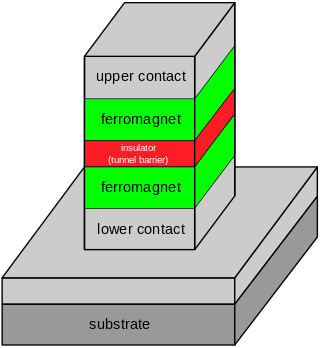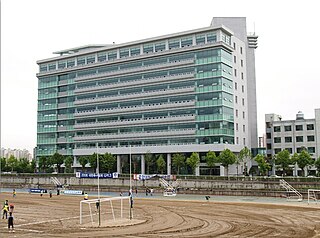
Computer memory stores information, such as data and programs for immediate use in the computer. The term memory is often synonymous with the term primary storage or main memory. An archaic synonym for memory is store.
Spintronics, also known as spin electronics, is the study of the intrinsic spin of the electron and its associated magnetic moment, in addition to its fundamental electronic charge, in solid-state devices. The field of spintronics concerns spin-charge coupling in metallic systems; the analogous effects in insulators fall into the field of multiferroics.
Non-volatile random-access memory (NVRAM) is random-access memory that retains data without applied power. This is in contrast to dynamic random-access memory (DRAM) and static random-access memory (SRAM), which both maintain data only for as long as power is applied, or forms of sequential-access memory such as magnetic tape, which cannot be randomly accessed but which retains data indefinitely without electric power.
Magnetoresistive random-access memory (MRAM) is a type of non-volatile random-access memory which stores data in magnetic domains. Developed in the mid-1980s, proponents have argued that magnetoresistive RAM will eventually surpass competing technologies to become a dominant or even universal memory. Currently, memory technologies in use such as flash RAM and DRAM have practical advantages that have so far kept MRAM in a niche role in the market.
Non-volatile memory (NVM) or non-volatile storage is a type of computer memory that can retain stored information even after power is removed. In contrast, volatile memory needs constant power in order to retain data.

Tunnel magnetoresistance (TMR) is a magnetoresistive effect that occurs in a magnetic tunnel junction (MTJ), which is a component consisting of two ferromagnets separated by a thin insulator. If the insulating layer is thin enough, electrons can tunnel from one ferromagnet into the other. Since this process is forbidden in classical physics, the tunnel magnetoresistance is a strictly quantum mechanical phenomenon, and lies in the study of spintronics.
Nano-RAM is a proprietary computer memory technology from the company Nantero. It is a type of nonvolatile random-access memory based on the position of carbon nanotubes deposited on a chip-like substrate. In theory, the small size of the nanotubes allows for very high density memories. Nantero also refers to it as NRAM.

Magnetic storage or magnetic recording is the storage of data on a magnetized medium. Magnetic storage uses different patterns of magnetisation in a magnetizable material to store data and is a form of non-volatile memory. The information is accessed using one or more read/write heads.

Giant magnetoresistance (GMR) is a quantum mechanical magnetoresistance effect observed in multilayers composed of alternating ferromagnetic and non-magnetic conductive layers. The 2007 Nobel Prize in Physics was awarded to Albert Fert and Peter Grünberg for the discovery of GMR, which also sets the foundation for the study of spintronics.
The magnetically sensitive transistor, also known as the spin transistor, spin field-effect transistor (spinFET), Datta–Das spin transistor or spintronic transistor, originally proposed in 1990 by Supriyo Datta and Biswajit Das, is an alternative design on the common transistor invented in the 1940s. This device was considered one of the Nature Milestones in Spin in 2008.

Ferroelectric RAM is a random-access memory similar in construction to DRAM but using a ferroelectric layer instead of a dielectric layer to achieve non-volatility. FeRAM is one of a growing number of alternative non-volatile random-access memory technologies that offer the same functionality as flash memory. An FeRAM chip contains a thin film of ferroelectric material, often lead zirconate titanate, commonly referred to as PZT. The atoms in the PZT layer change polarity in an electric field, thereby producing a power-efficient binary switch. However, the most important aspect of the PZT is that it is not affected by power disruption or magnetic interference, making FeRAM a reliable nonvolatile memory.

A spin valve is a device, consisting of two or more conducting magnetic materials, whose electrical resistance can change between two values depending on the relative alignment of the magnetization in the layers. The resistance change is a result of the giant magnetoresistive effect. The magnetic layers of the device align "up" or "down" depending on an external magnetic field. In the simplest case, a spin valve consists of a non-magnetic material sandwiched between two ferromagnets, one of which is fixed (pinned) by an antiferromagnet which acts to raise its magnetic coercivity and behaves as a "hard" layer, while the other is free (unpinned) and behaves as a "soft" layer. Due to the difference in coercivity, the soft layer changes polarity at lower applied magnetic field strength than the hard one. Upon application of a magnetic field of appropriate strength, the soft layer switches polarity, producing two distinct states: a parallel, low-resistance state, and an antiparallel, high-resistance state.
Resistive random-access memory is a type of non-volatile (NV) random-access (RAM) computer memory that works by changing the resistance across a dielectric solid-state material, often referred to as a memristor. One major advantage of ReRAM over other NVRAM technologies is the ability to scale below 10nm.
Racetrack memory or domain-wall memory (DWM) is an experimental non-volatile memory device under development at IBM's Almaden Research Center by a team led by physicist Stuart Parkin. In early 2008, a 3-bit version was successfully demonstrated. If it were to be developed successfully, racetrack memory would offer storage density higher than comparable solid-state memory devices like flash memory.

Fusion Technology Center is a building for research on "fusion technologies" in South Korea. It was constructed under the sponsorship of the city of Seoul and Hanyang University. The headquarters of Asian Research Network is in this center. In January 2009, Taro Aso, the former Prime Minister of Japan visited this building to encourage researchers.
Spin engineering describes the control and manipulation of quantum spin systems to develop devices and materials. This includes the use of the spin degrees of freedom as a probe for spin based phenomena. Because of the basic importance of quantum spin for physical and chemical processes, spin engineering is relevant for a wide range of scientific and technological applications. Current examples range from Bose–Einstein condensation to spin-based data storage and reading in state-of-the-art hard disk drives, as well as from powerful analytical tools like nuclear magnetic resonance spectroscopy and electron paramagnetic resonance spectroscopy to the development of magnetic molecules as qubits and magnetic nanoparticles. In addition, spin engineering exploits the functionality of spin to design materials with novel properties as well as to provide a better understanding and advanced applications of conventional material systems. Many chemical reactions are devised to create bulk materials or single molecules with well defined spin properties, such as a single-molecule magnet. The aim of this article is to provide an outline of fields of research and development where the focus is on the properties and applications of quantum spin.
Everspin Technologies is a public semiconductor company headquartered in Chandler, Arizona, United States. It develops and manufactures discrete magnetoresistive RAM or magnetoresistive random-access memory (MRAM) products, including Toggle MRAM and Spin-Transfer Torque MRAM (STT-MRAM) product families. It also licenses its technology for use in embedded MRAM (eMRAM) applications, magnetic sensor applications as well as performs backend foundry services for eMRAM.
Grandis, Inc. was founded in 2002 by Dr. Paul Nguyen and Bill Almon. Farhad Tabrizi later joined as CEO. It was backed by venture capital firms such as Sevin Rosen Funds and Matrix Partners to pioneer non-volatile solutions based on spintronics. The solutions it developed were thin-film memory, which included the invention of spin transfer torque - random access memory (STT-RAM).
Bernard Dieny is a research scientist and an entrepreneur. He is Chief Scientist at SPINTEC, a CEA/CNRS/UGA research laboratory that he co-founded in 2002 in Grenoble, France. He is also co-founder of two startup companies: Crocus Technology on MRAM and magnetic sensors in 2006 and EVADERIS on circuits design in 2014.
Guohan Hu is an electrical engineer specializing in magnetic storage and spintronics, and especially in the use of spin-transfer torque in magnetoresistive RAM, a type of non-volatile random-access memory. She works for IBM Research at the Thomas J. Watson Research Center as a distinguished research staff member and manager of the MRAM Materials and Devices group.








